Progress: LEED Certified Buildings
All new construction projects and major renovations on Aquinas' campus are LEED (Leadership in Energy and Environmental Design) certified by the U.S. Green Building Council. This commitment ensures that quality, environmentally considerate buildings and projects are undertaken on campus. Find more information about our LEED Certified buildings below.
Albertus Magnus Hall of Science
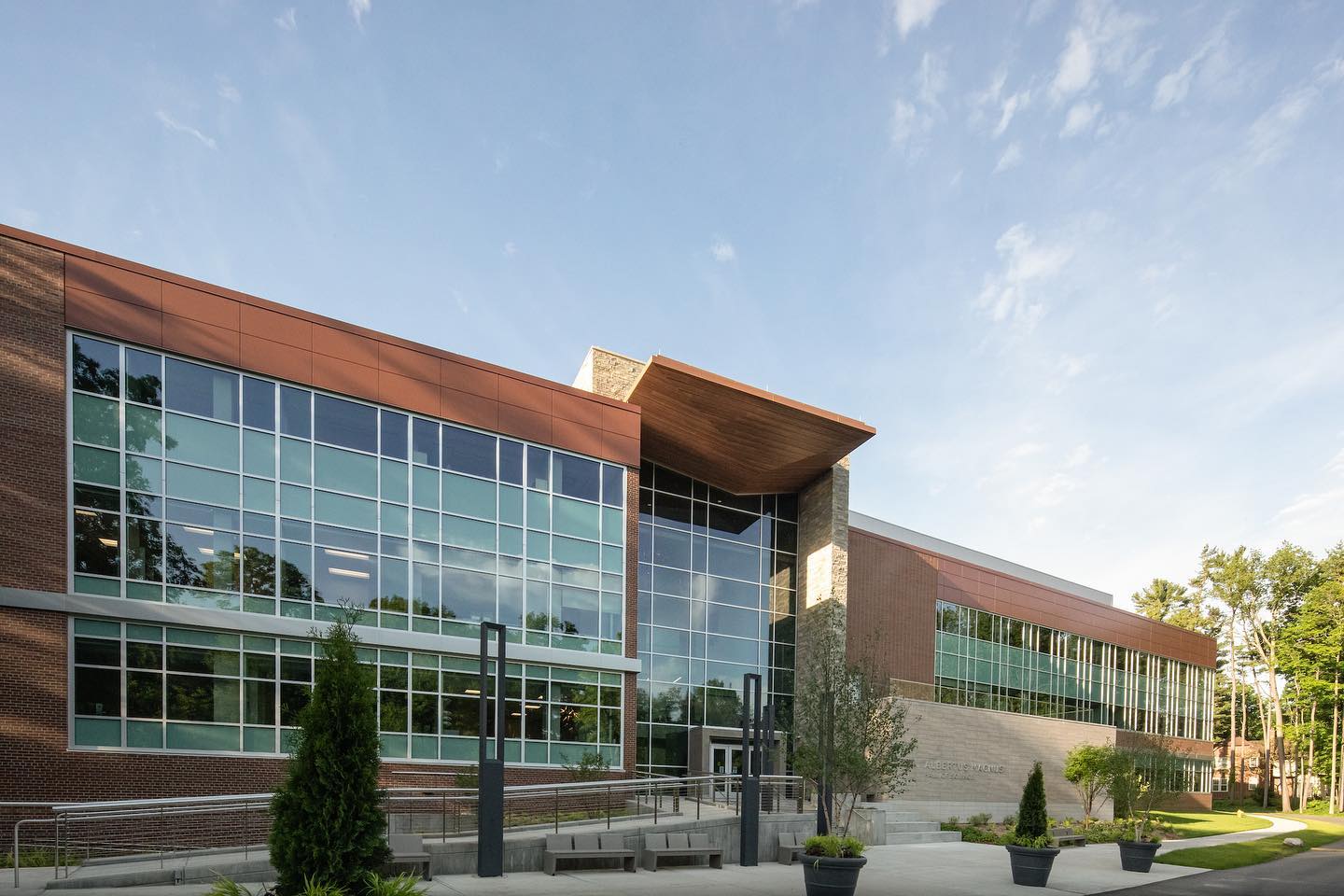 The Albertus Magnus Hall of Science was expanded and renovated in 2020. The 89,000
square foot building doubled in size and is the first building on campus to achieve
LEED Gold certification (LEED v4 BD+C). The building overlooks Wege Pond and Coldbrook
Creek on the south end of campus. Extensive windows along the building's exterior
facilitate daylighting, reducing the need for artificial light in classrooms and offices.
The building boasts the first green roof on campus, used as a demonstration technology
and as a gathering area for faculty, staff, and students. The building has no outdoor
irrigation and all toilets and faucets are low flow, contributing to 40% water savings
annually.
The Albertus Magnus Hall of Science was expanded and renovated in 2020. The 89,000
square foot building doubled in size and is the first building on campus to achieve
LEED Gold certification (LEED v4 BD+C). The building overlooks Wege Pond and Coldbrook
Creek on the south end of campus. Extensive windows along the building's exterior
facilitate daylighting, reducing the need for artificial light in classrooms and offices.
The building boasts the first green roof on campus, used as a demonstration technology
and as a gathering area for faculty, staff, and students. The building has no outdoor
irrigation and all toilets and faucets are low flow, contributing to 40% water savings
annually. Our Lady Seat of Wisdom Chapel
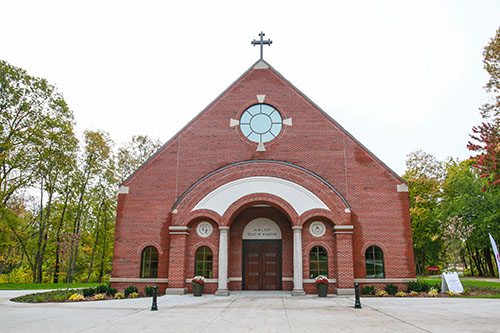 Our Lady Seat of Wisdom Chapel is LEED Certified (2019). Construction of the Chapel
was completed in 2018. This 250-seat Chapel is the first building in the college's
history to be constructed specifically as a Chapel. It is located in the heart of
campus to ensure that all members of the campus are in close proximity to the Chapel.
In addition, everyone from the Aquinas community along with neighbors walking through
can enjoy one of the newest editions. The building has numerous notable green features
as follows. When constructing the building, 89% of construction waste was diverted
from landfills. The stormwater runoff system is 100% diverted to an adjacent stream.
To save water, low-flow faucets and toilets reduce water usage by 25%. Outside of
the building, 95% of the surrounding area is vegetated and there is reduced parking
due to bicycle facilities.
Our Lady Seat of Wisdom Chapel is LEED Certified (2019). Construction of the Chapel
was completed in 2018. This 250-seat Chapel is the first building in the college's
history to be constructed specifically as a Chapel. It is located in the heart of
campus to ensure that all members of the campus are in close proximity to the Chapel.
In addition, everyone from the Aquinas community along with neighbors walking through
can enjoy one of the newest editions. The building has numerous notable green features
as follows. When constructing the building, 89% of construction waste was diverted
from landfills. The stormwater runoff system is 100% diverted to an adjacent stream.
To save water, low-flow faucets and toilets reduce water usage by 25%. Outside of
the building, 95% of the surrounding area is vegetated and there is reduced parking
due to bicycle facilities.
St. Rose of Lima Hall (Formerly Ravine Apartment E)
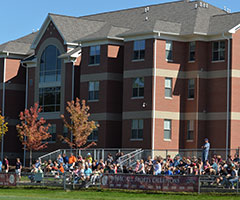
Aquinas College’s St. Rose of Lima Hall (formerly Apartment E) was awarded basic LEED (Leadership in Energy & Environmental Design) certification from the U.S. Green Building Council (USGBC). The USGBC uses LEED certification to designate the world’s greenest, energy-efficient and high-performing buildings. St. Rose of Lima Hall boasts a viewout basement to allow daylighting and views of the campus athletic field. It is a replica of St. Martin de Porres Hall. The 29,178 square-foot residential space was certified in July 2016. More Info
Alksnis Athletics & Recreation Building
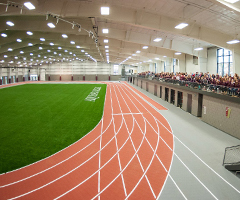 Aquinas College’s new Alksnis Athletics & Recreation Building has recently been awarded
LEED (Leadership in Energy & Environmental Design) Silver certification from the U.S.
Green Building Council (USGBC). The USGBC uses LEED certification to designate the
world’s greenest, energy-efficient and high-performing buildings.
Aquinas College’s new Alksnis Athletics & Recreation Building has recently been awarded
LEED (Leadership in Energy & Environmental Design) Silver certification from the U.S.
Green Building Council (USGBC). The USGBC uses LEED certification to designate the
world’s greenest, energy-efficient and high-performing buildings. The 70,000-square-foot athletic space was designed and constructed in collaboration by Integrated Architecture and Rockford Construction. Construction began in November 2013 and was completed in October 2014. The building was certified under LEED NC, v.3. More Info
Sturrus Sports & Fitness Center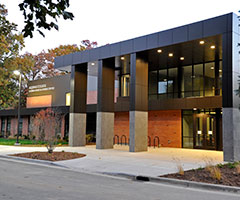 In 2010, Aquinas College's Fieldhouse was completely renovated to become the Sturrus
Sports & Fitness Center. The renovation was done through Rockford Construction and
the building achieved basic LEED certification (LEED NC 2.2).
In 2010, Aquinas College's Fieldhouse was completely renovated to become the Sturrus
Sports & Fitness Center. The renovation was done through Rockford Construction and
the building achieved basic LEED certification (LEED NC 2.2).
Architect: Integrated Architecture
Size: 57,000 sq. ft.
Green Features: Building systems are designed to exceed energy savings of comparable buildings by 46 percent. Cooling and refrigeration systems support early compliance with the Montreal Protocol. Over 95 percent of all construction waste was diverted from local landfills through recycling and reuse.
Academic Building: Second Floor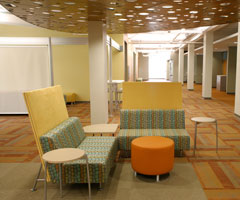 Completed in 1955, the Academic Building housed offices for College administrators,
staff and faculty, in addition to classrooms and the library. When the library moved
to its new LEED certified facility in 2006, the second level of the Academic Building
was left vacant. The College decided to renovate and update the building's second
level. This renovation was done through Rockford Construction and it has earned silver
LEED certification from the USGBC (LEED CI, v.2). During the renovation process, over
75% of construction waste was diverted from a landfill.
Completed in 1955, the Academic Building housed offices for College administrators,
staff and faculty, in addition to classrooms and the library. When the library moved
to its new LEED certified facility in 2006, the second level of the Academic Building
was left vacant. The College decided to renovate and update the building's second
level. This renovation was done through Rockford Construction and it has earned silver
LEED certification from the USGBC (LEED CI, v.2). During the renovation process, over
75% of construction waste was diverted from a landfill.
To maximize energy efficiency on the second floor of the Academic Building, HVAC systems,
lighting systems, and appliances were reviewed and selected based on energy performance.
Daylight sensors were an addition to the lighting controls, turning off the lights
when they sense adequate natural light for the particular space. The second floor
of the Academic Building houses classrooms and offices, as well as the Center for
Sustainability. This space serves as a common area where students and faculty can
come together, increasing communication.
St. Martin de Porres Hall (Formerly Ravine Apartment D)
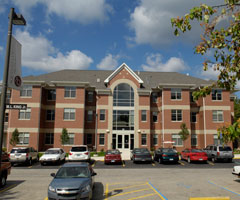 Aquinas College has experienced increased growth in the student population in recent
years, resulting in an increasing demand for on-campus housing. To address this issue,
the College decided to construct a new housing structure for upperclassmen. St. Martin
de Porres Hall received LEED certification at the basic level after construction was
completed in 2008 (LEED NC, v.2.2). Tight controls were established during the building
process which reduced construction waste and allowed the project team to recycle 95%
of the construction and land clearing debris.
Aquinas College has experienced increased growth in the student population in recent
years, resulting in an increasing demand for on-campus housing. To address this issue,
the College decided to construct a new housing structure for upperclassmen. St. Martin
de Porres Hall received LEED certification at the basic level after construction was
completed in 2008 (LEED NC, v.2.2). Tight controls were established during the building
process which reduced construction waste and allowed the project team to recycle 95%
of the construction and land clearing debris.
Located on the east side of campus, the Aquinas College St. Martin de Porres Hall
the facility overlooks a nature preserve area and creek bed. Stormwater runoff is
routed into infiltration basins, which are shallow impoundments designed to allow
stormwater to infiltrate into the ground. This helps to recharge local aquifers and
it is believed to have high pollutant removal efficiency. State-of-the-art HVAC and
electrical systems were installed to reduce energy consumption. Water use was reduced
23.2% by carefully selecting water-efficient fixtures and equipment. In accordance
with the College’s goals for high systems performance, this facility was designed
to operate efficiently.
Grace Hauenstein Library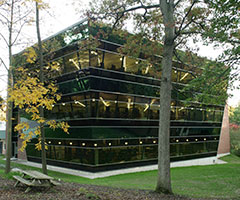 The Grace Hauenstein Library received LEED Silver from the USGBC (LEED NC, v. 2.1).
Construction of the library was completed in 2006. Waste Not: Over 75% of all construction
waste was diverted from landfills through recycling and reuse.
The Grace Hauenstein Library received LEED Silver from the USGBC (LEED NC, v. 2.1).
Construction of the library was completed in 2006. Waste Not: Over 75% of all construction
waste was diverted from landfills through recycling and reuse.
Enlightened Lighting: Large windows allow daylight to be maintained in 75% of spaces
and views in 90% of the seated spaces. This reduces the need for artificial lighting.
In addition, daylight sensors were installed to turn off the lights when enough natural
light is adequate to perform tasks in a given space.
Saving Water: Water use was reduced 30% by equipping the women’s and men’s restrooms
with dual flush water closets, censored faucets and ultra-low flow urinals. Also,
kitchen and janitor sinks were fitted with faucets that included aerators.
Clearing the Air: An indoor air quality plan was put into place during construction
to reduce the number of indoor air contaminants that are odorous, possibly irritating,
or harmful to the installers and/or occupants. All adhesives, paints, sealants, and
coatings are low or no-VOC (volatile organic compound) emitting. Carpets meet the
Carpet and Rug Institute Green Label Plus criteria. Once the project was completed,
the new HVAC systems were purified to maintain the indoor air quality. A green cleaning
program is also in place to assure clean and healthy air quality is maintained.
Local vendors, local materials: Some of the building materials (20%) were harvested,
extracted, recovered or manufactured from facilities within 500 miles of Aquinas.
By purchasing materials from local manufacturers, we stimulate the regional economy
and reduce the environmental impact of transporting materials to the job site.
Education displays are in place to highlight the green components of the Grace Hauenstein
Library.
CONTACT INFO
Center for Sustainability
Albertus Hall, Rm 129
(616) 632-1994
sustainability@aquinas.edu